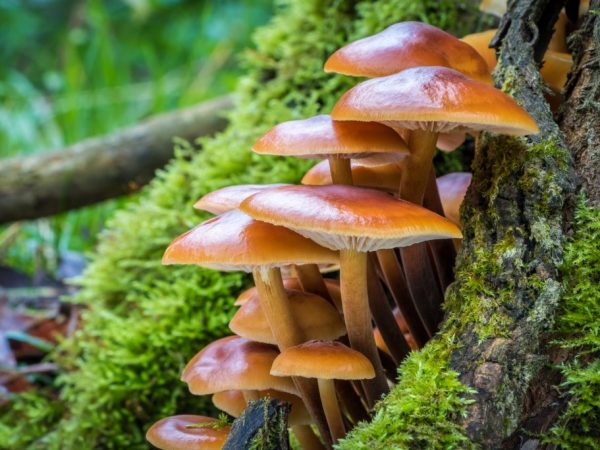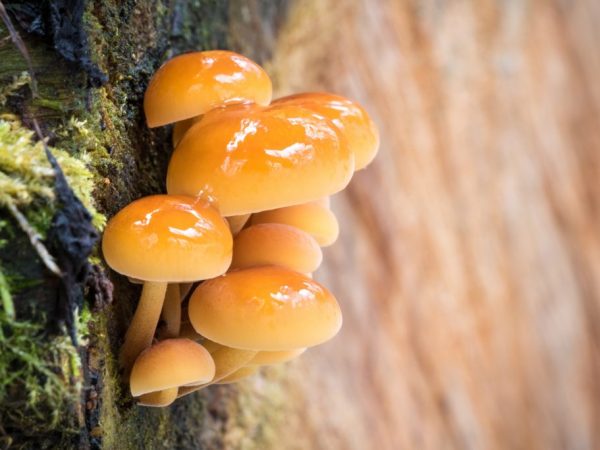Characteristics of the winter honey fungus (flammulina)
Winter mushrooms are edible mushrooms from the Ryadovkovy family. They begin to grow from the end of summer, they are harvested in winter, even from under the snow. Winter mushroom has several synonymous names: velvety-footed flammulina and enokitake, or winter mushroom.

Characteristics of the mushroom winter honey
Description of the appearance of the mushroom
According to the species characteristics, the caps have a diameter of 2 to 10 cm. They are smooth and slimy to the touch. Mushrooms change color depending on the tree they grow on. They are found even in the city center, on the sides of polluted roads, if there are remains of tree trunks there. Such specimens should be left alone to collect: they contain a large amount of harmful compounds, in particular heavy metal ions. Their use, at best, threatens with serious poisoning. Depending on the place of germination, they are:
- brownish yellow;
- yellow-orange;
- bright yellow with dark blotches;
- dark yellow with light edges.
By the way. The edges of the cap are lighter than its central part.
In young specimens, the cap is convex, with tucked edges; it becomes prostrate during adulthood. The plates, like the caps, change appearance, depending on the place of growth and can vary in color from white to reddish-yellow. They can grow to the leg. Their color ranges from white to light yellow. With the growth period, the shade becomes closer to brown. Spores for reproduction are white and different in shape.
The flesh of flammulina is thin, but dense, creamy in color. It tastes good, slightly sour and has a persistent mushroom smell. According to the description, the stem of the mushroom is thin, about 10 cm in length and up to 1 cm in thickness. It has a cylindrical shape, brown color and dense structure. There is no "skirt" (ring) on the leg - the remains of a private veil that covers the hymenophore plates in immature fruiting bodies and creates favorable conditions for the formation of spores.
The fungus is found on dead wood or weakened (damaged) plants. More often it grows on moist soils in gardens, squares and forests near rivers, streams, poplars and willows are chosen among tree stumps. Flammulina bears fruit in groups - aggregates. Winter honey agaric is a parasite that parasitizes sick and damaged trees. If the mycelium develops on dead wood, then velvety-footed flammulina will belong to saprophytes.
When collecting winter mushrooms, it must be remembered that there are false and poisonous mushrooms similar to them. To distinguish a false mushroom and not collect it, you should examine the stem of the fruiting body. There is a light ring on it, and the cap of edible mushrooms is covered with pronounced scales.
Benefit and harm
The composition of the mushroom contains a large number of antioxidants: ergothioneine and proflamine. They improve the state of the immune system and the work of the heart.There are also microelements: copper, iodine, potassium, calcium, iron, proteins and vitamins C, PP, K and group B. By the content of zinc, potassium, copper, phosphorus, iodine and manganese, flammulin is comparable to beef and milk.
Flammulina has the following beneficial properties:
- renews skin cells, making it firm and smooth;
- accelerates the maturation of lymphocytes (blood cells);
- restores intestinal microflora;
- improves the condition of blood vessels;
- supports liver health;
- reduces inflammation;
- lowers blood cholesterol levels;
- improves performance, restoring the energy potential of the body.
The composition of the winter mushroom also includes flammulin, which has the ability to stop the formation of metastases in sarcoma.

Eating mushrooms has a positive effect on the body
The benefits of flammulina are its antiviral and antibacterial properties. It contains lectin and P-D-glucan and exhibits immunomodulatory properties.
For your information. Tinctures and decoctions from its fruiting bodies are an effective remedy for impotence.
Flammulin does not harm health if a person is not allergic to it (to the components of the fungus), and during processing it was not mixed with poisonous representatives. You cannot eat them for pregnant women and children under 3 years old: they contain substances that the stomach digests for a long time.
Groups of fungi damage only trees, in particular fruit varieties. To avoid this, it is necessary to immediately carefully coat the damaged stems with oil paint in order to protect them from possible spores and the development of fungal mycelium.
Application
Mushrooms are used both in medicine and in cooking.
In cooking
According to its nutritional value, winter honey agaric belongs to the 4th category. Due to its bright appearance, winter mushrooms are popular ingredients in dishes. Before use, they are washed from dirt, the dark parts are cut off from them. Mushrooms are cut in pieces or boiled whole for about half an hour. To make the sauce, they are fried or stewed. They are also fried dipped in bread crumbs.
Irina Selyutina (Biologist):
Before preparing honey mushrooms, they are pre-boiled for 40-60 minutes with the obligatory drainage of the liquid after that. This is done to remove toxic compounds that are not resistant to high temperatures in the pulp.
Mushrooms are often refrigerated after boiling and drying. They are pickled, salted and dried. Before boiling, the caps are cleaned of mucus. Legs are rarely added to salads and sauces, because they are tough in structure. But for stews, caviar and fillings, they are suitable. Winter honey mushroom is combined with fish, meat and vegetables.
Advice. When cooking (stewing, frying, salting), cut the legs slightly below the cap. But if the mushrooms are old, be sure to remove the plates from the underside of the cap.
In medicine
In Japan, winter honey is used to create a vaccine against various kinds of neoplasms. Winter mushrooms have antioxidant properties and protect a person from cardiovascular diseases. Nutritionists recommend adding them to your diet, because they are low in calories. Extracts from them inhibit the growth of Staphylococcus aureus.
In Japanese and Korean medicine, preparations based on winter honey fungus are prescribed for the treatment of leukemia, sarcoma, and adenoma. In the modern world, they even learned to use the beneficial properties of mushrooms for cosmetic purposes. They are added:
- in face masks;
- in body lotions;
- in creams that fight flaking and dryness.
Honey mushrooms are also endowed with a rejuvenating effect, which is highly valued in cosmetology.
Growing methods
The type of flammulin is grown in artificial conditions in two ways: firstly, on a balcony or in a specially equipped room, and secondly, in the open air.
Method number 1: On the balcony or in a specially equipped room
For this you will need:
- sunflower seed peel;
- buckwheat shell;
- wood sawdust;
- glass jars of 2 liters;
- finely chopped corn stalk;
- the thick that remains after boiling and sucking off the barley wort (when brewing beer).
All substances are mixed and insisted for 24 hours. After that, squeeze out the water, fill the jars with the mixture to half and lower the mycelium there. The container is covered with lids with holes. After 15 days, the mycelium will begin to grow and live, edible mushrooms can be observed. From one can with a capacity of 2 liters, up to 1 kg of mushrooms is obtained. It is stored in a shaded place with a temperature of + 10 ... + 12 ° C. This is an important condition and must be strictly observed.
Harvesting is carried out by carefully cutting off the leg with a sharp object or twisting the fruit body from the substrate. Overgrown and rotten specimens are not used: they are thrown away.
Method number 2: Outdoors
In addition to growing at home, they also use the cultivation of flammulina in their summer cottages. Here, the mycelium can be settled on the trunks or stumps of deciduous species (birch, poplar, alder, walnut, willow, horse chestnut, robinia, beech, linden, ash). For planting, choose logs 30-50 cm long and 15-50 cm in diameter. The best time is considered to be spring (April, May) and autumn (September).
The mycelium is populated into specially drilled holes in the surface of the logs and stacked in piles. Attention! Decide already at this stage where you will have the "top" and "bottom" of the logs and accordingly place the holes for the mycelium. At an air temperature of about + 20 ℃, the germination of the mycelium will take 3-4 months. When this happens, the piles are disassembled, and the logs are buried strictly vertically in a pre-selected shady place of the site to a depth of 10-15 cm.
If the mycelium was planted in the spring on soft wood, then you can already harvest the first crop next fall and winter. If you planted in the fall, then you can eat the first mushrooms in the spring. The optimum temperature for the development of a winter fungus is considered to be + 8 ... + 12 ℃. In winter, plantings are also checked from time to time for the presence of a crop.
In principle, these mushrooms are not demanding to care for, and you only have to water the logs from time to time in the summer and cover them from the sun's rays.
Irina Selyutina (Biologist):
Since we often come across the concepts of "hard" and "soft" wood when growing mushrooms in artificial conditions, let's just remember that these are:
Softwood: coniferous wood (spruce, pine, cedar, larch), which grow quickly enough. It is used in construction, papermaking, pressed wood and shipping boxes. It is easy to saw, drill, bend. By the way. Trees with soft wood include linden, aspen, willow, poplar.
Hardwood: wood of slowly growing species of broad-leaved trees (oak, ash, birch, horse chestnut, alder, hornbeam, mahogany walnut, teak, etc.), which is much more difficult to cut, but almost does not rot and is highly durable.
By the way. On soft wood flammulina velvety-footed grows for 3-4 years, on hard wood 5-7 years, on stumps up to 10 years.
Conclusion
Winter mushroom is a late mushroom that is harvested from August to the end of December. In the presence of suitable winter conditions with thaws, mushroom picking can be continued until March. It grows in many countries including Japan and Korea. When growing, a nutritious substrate is used, which allows you to get delicious mushrooms at home. The collection of such a crop is carried out year-round. Edible winter mushrooms have a false analogue - a poisonous gallery. According to the description, it looks like them in appearance, but it has a ring on its leg.



